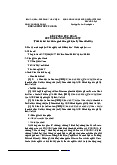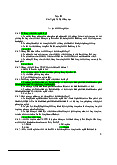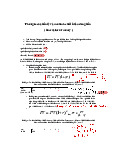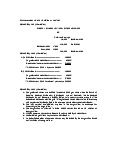



















Preview text:
CHAPTER 3
FINANCIAL STATEMENTS ANALYSIS AND FINANCIAL MODELS
Solutions to Questions and Problems
NOTE: All end-of-chapter problems were solved using a spreadsheet. Many problems require multiple
steps. Due to space and readability constraints, when these intermediate steps are included in this
solutions manual, rounding may appear to have occurred. However, the final answer for each problem is
found without rounding during any step in the problem. Basic 1.
Using the DuPont identity, the ROE is:
ROE = (Profit margin)(Total asset turnover)(Equity multiplier) ROE = (.0605)(1.87)(1.43) ROE = .1618, or 16.18% 2. The equity multiplier is: EM = 1 + D/E EM = 1 + .63 EM = 1.63
One formula to calculate return on equity is: ROE = ROA(EM) ROE = .084(1.63) ROE = .1369, or 13.69% ROE can also be calculated as: ROE = NI/TE So, net income is: Net income = ROE(TE) Net income = .1369($645,000) Net income = $88,313.40 3.
This is a multistep problem involving several ratios. The ratios given are all part of the DuPont
identity. The only DuPont identity ratio not given is the profit margin. If we know the profit margin,
we can find the net income since sales are given. So, we begin with the DuPont identity:
ROE = .11 = (PM)(TAT)(EM) = (PM)(S/TA)(1 + D/E)
Solving the DuPont identity for profit margin, we get:
PM = [(ROE)(TA)]/[(1 + D/E)(S)]
PM = [(.11)($2,532)]/[(1 + .57)($5,987)] PM = .0296
Now that we have the profit margin, we can use this number and the given sales figure to solve for net income: PM = .0296 = NI/S NI = .0296($5,987) Net income = $177.40 4.
An increase of sales to $23,345 is an increase of:
Sales increase = ($23,345 – 20,300)/$20,300 Sales increase = .15, or 15%
Assuming costs and assets increase proportionally, the pro forma financial statements will look like this: Pro forma income statement Pro forma balance sheet Sales $23,345.00 Assets $ 54,050 Debt $ 26,900.00 Costs 19,665.00 Equity 21,397.20 EBIT 3,680.00 Total $ 54,050 Total $48,297.20 Taxes (21%) 772.80 Net income $ 2,907.20
The payout ratio is constant, so the dividends paid this year is the payout ratio from last year times net income, or:
Dividends = ($1,400/$2,528)($2,907.20) Dividends = $1,610
The addition to retained earnings is:
Addition to retained earnings = $2,907.20 – 1,610
Addition to retained earnings = $1,297.20 And the new equity balance is: Equity = $20,100 + 1,297.20 Equity = $21,397.20 So the EFN is:
EFN = Total assets – Total liabilities and equity EFN = $54,050 – 48,297.20 EFN = $5,752.80 5.
The maximum percentage sales increase without issuing new equity is the sustainable growth rate.
To calculate the sustainable growth rate, we first need to calculate the ROE, which is: ROE = NI/TE ROE = $2,325/$10,300 ROE = .2257, or 22.57%
The plowback ratio, , is one minus the payout ratio, so: b b = 1 – .40 b = .60
Now we can use the sustainable growth rate equation to get:
Sustainable growth rate = (ROE × b)/[1 – (ROE × b)]
Sustainable growth rate = [.2257(.60)]/[1 – .2257(.60)]
Sustainable growth rate = .1567, or 15.67%
So, the maximum dollar increase in sales is:
Maximum increase in sales = $8,700(.1567)
Maximum increase in sales = $1,362.89 6.
We need to calculate the retention ratio to calculate the sustainable growth rate. The retention ratio is: b = 1 – .25 b = .75
Now we can use the sustainable growth rate equation to get:
Sustainable growth rate = (ROE × )/[1 – (ROE × b b)]
Sustainable growth rate = [.141(.75)]/[1 – .141(.75)]
Sustainable growth rate = .1183, or 11.83% 7.
We must first calculate the ROE using the DuPont ratio to calculate the sustainable growth rate. The ROE is: ROE = (PM)(TAT)(EM) ROE = (.052)(3.2)(.95) ROE = .1581, or 15.81%
The plowback ratio is one minus the dividend payout ratio, so: b = 1 – .35 b = .65
Now we can use the sustainable growth rate equation to get:
Sustainable growth rate = (ROE × )/[1 – (ROE × b b)]
Sustainable growth rate = [.1581(.65)]/[1 – .1581(.65)]
Sustainable growth rate = .1145, or 11.45% 8.
An increase of sales to $11,092 is an increase of:
Sales increase = ($11,092 – 9,400)/$9,400 Sales increase = .18, or 18%
Assuming costs and assets increase proportionally, the pro forma financial statements will look like this: Pro forma income statement Pro forma balance sheet Sales $ 11,092 Assets $ 23,954 Debt $ 8,400 Costs 7,941 Equity 15,051 Net income $ 3,151 Total $ 23,954 Total $ 23,451
If no dividends are paid, the equity account will increase by the net income, so: Equity = $11,900 + 3,151 Equity = $15,051 So the EFN is:
EFN = Total assets – Total liabilities and equity EFN = $23,954 – 23,451 EFN = $503 9. a.
First, we need to calculate the current sales and change in sales. The current sales are next
year’s sales divided by one plus the growth rate, so:
Current sales = Next year’s sales/(1 + ) g
Current sales = $320,000,000/(1 + .16) Current sales = $275,862,069 And the change in sales is:
Change in sales = $320,000,000 – 275,862,069 Change in sales = $44,137,931
We can now complete the current balance sheet. The current assets, fixed assets, and short-term
debt are calculated as a percentage of current sales. The long-term debt and par value of stock
are given. The plug variable is the addition to retained earnings. So: Assets Liabilities and equity Current assets $55,172,414 Accounts payable $41,379,310 Long-term debt $105,000,000 Fixed assets 193,103,448 Common stock $45,000,000 Accumulated retained earnings 56,896,552 Total equity $101,896,552 Total assets $248,275,862 Total liabilities and equity $248,275,862 b.
We can use the equation from the text to answer this question. The assets/sales and debt/sales
are the percentages given in the problem, so: (Assets) (Debt ) EFN = Sales × ΔSales – Sales
× ΔSales – (PM × Projected sales) × (1 – ) d
EFN = (.20 + .70) × $44,137,931 – (.15 × $44,137,931) – [(.09 × $320,000,000) × (1 – .30)] EFN = $12,943,448 c.
The current assets, fixed assets, and short-term debt will all increase at the same percentage as
sales. The long-term debt and common stock will remain constant. The accumulated retained
earnings will increase by the addition to retained earnings for the year. We can calculate the
addition to retained earnings for the year as:
Net income = Profit margin × Sales Net income = .09($320,000,000) Net income = $28,800,000
The addition to retained earnings for the year will be the net income times one minus the
dividend payout ratio, which is:
Addition to retained earnings = Net income(1 – ) d
Addition to retained earnings = $28,800,000(1 – .30)
Addition to retained earnings = $20,160,000
So, the new accumulated retained earnings will be:
Accumulated retained earnings = $56,896,552 + 20,160,000
Accumulated retained earnings = $77,056,552
The pro forma balance sheet will be: Assets Liabilities and equity Current assets $64,000,000 Accounts payable $48,000,000 Long-term debt $105,000,000 Fixed assets $224,000,000 Common stock $45,000,000 Accumulated retained earnings 77,056,552 Total equity $122,056,552 Total assets $288,000,000 Total liabilities and equity $275,056,552 The EFN is:
EFN = Total assets – Total liabilities and equity
EFN = $288,000,000 – 275,056,552 EFN = $12,943,448 10. a.
The plowback ratio is one minus the dividend payout ratio, so: b = 1 – .25 b = .75
Now, we can use the sustainable growth rate equation to get:
Sustainable growth rate = (ROE × )/[1 – (ROE × b b)]
Sustainable growth rate = [.1105(.75)]/[1 – .1105(.75)]
Sustainable growth rate = .0904, or 9.04% b.
It is possible for the sustainable growth rate and the actual growth rate to differ. If any of the
actual parameters in the sustainable growth rate equation differ from those used to compute the
sustainable growth rate, the actual growth rate will differ from the sustainable growth rate.
Since the sustainable growth rate includes ROE in the calculation, this also implies that changes
in the profit margin, total asset turnover, or equity multiplier will affect the sustainable growth rate. c.
The company can increase its growth rate by doing any of the following:
- Increase the debt-to-equity ratio by selling more debt or repurchasing stock.
- Increase the profit margin, most likely by better controlling costs.
- Decrease its total assets/sales ratio; in other words, utilize its assets more efficiently.
- Reduce the dividend payout ratio. Intermediate
11. The solution requires substituting two ratios into a third ratio. Rearranging Debt/Total assets: Firm A Firm B D/TA = .60 D/TA = .35 (TA – E)/TA = .60 (TA – E)/TA = .35 (TA/TA) – (E/TA) = .60 (TA/TA) – (E/TA) = .35 1 – (E/TA) = .60 1 – (E/TA) = .35 E/TA = .40 E/TA = .65 E = .40(TA) E = .65(TA)
Rearranging ROA = Net income/Total assets, we find: NI/TA = .045 NI/TA = .08 NI = .045(TA) NI = .08(TA)
Since ROE = Net income/Equity, we can substitute the above equations into the ROE formula, which yields: ROE = .045(TA)/.40(TA) ROE = .08(TA)/.65(TA) ROE = .045/.40 ROE = .08/.65 ROE = .1125, or 11.25% ROE = .1231, or 12.31%
12. Profit margin = Net income/Sales
Profit margin = –£26,382/£315,650
Profit margin = –.0836, or –8.36%
As long as both net income and sales are measured in the same currency, there is no problem; in fact,
except for some market value ratios like EPS and BVPS, none of the financial ratios discussed in the
text are measured in terms of currency. This is one reason why financial ratio analysis is widely used
in international finance to compare the business operations of firms and/or divisions across national
economic borders. The net income in dollars is:
Net income = Profit margin × Sales
Net income = –.0836($385,815) Net income = –$32,246.38 13. a.
The equation for external funds needed is: (Assets) (Debt ) Sales Sales EFN = × ΔSales –
× ΔSales – (PM × Projected sales) × (1 – ) d where:
Assets/Sales = $26,625,000/$24,046,000 = 1.11
ΔSales = Current sales × Sales growth rate = $24,046,000(.15) = $3,606,900
Short-term debt/Sales = $5,200,000/$24,046,000 = .2163
Profit margin = Net income/Sales = $1,988,250/$24,046,000 = .0827
Projected sales = Current sales × (1 + Sales growth rate) = $24,046,000(1 + .15) = $27,652,900
d = Dividends/Net income = $397,600/$1,988,250 = .20 so:
EFN = (1.11 × $3,606,900) – (.2163 × $3,606,900) – (.0827 × $27,652,900) × (1 – .20) EFN = $1,384,503 b.
The current assets, fixed assets, and short-term debt will all increase at the same percentage as
sales. The long-term debt and common stock will remain constant. The accumulated retained
earnings will increase by the addition to retained earnings for the year. We can calculate the
addition to retained earnings for the year as:
Net income = Profit margin × Sales
Net income = .0827($27,652,900) Net income = $2,286,488
The addition to retained earnings for the year will be the net income times one minus the
dividend payout ratio, which is:
Addition to retained earnings = Net income(1 – ) d
Addition to retained earnings = $2,286,488(1 – .20)
Addition to retained earnings = $1,829,248
So, the new accumulated retained earnings will be:
Accumulated retained earnings = $12,425,000 + 1,829,248
Accumulated retained earnings = $14,254,248
The pro forma balance sheet will be: Assets Liabilities and equity Current assets $8,331,750 Accounts payable $5,980,000 Long-term debt $5,900,000 Fixed assets 22,287,000 Common stock $3,100,000 Accumulated retained earnings 14,254,248 Total equity $17,354,248 Total assets $30,618,750 Total liabilities and equity $29,234,248 The EFN is:
EFN = Total assets – Total liabilities and equity
EFN = $30,618,750 – 29,234,248 EFN = $1,384,503 c. The ROE is: ROE = Net income/Total equity ROE = $1,988,250/$15,525,000 ROE = .1281, or 12.81% And the retention ratio is:
b = Retention ratio = Retained earnings/Net income
b = $1,590,650/$1,988,250 b = .80
Now, we can use the sustainable growth rate equation to get:
Sustainable growth rate = (ROE × )/[1 – (ROE × b b)]
Sustainable growth rate = [.1281(.80)]/[1 – .1281(.80)]
Sustainable growth rate = .1142, or 11.42% d.
The company cannot just cut its dividends to achieve the forecast growth rate. As shown below,
even with a zero dividend policy, the EFN will still be $927,263. Assets Liabilities and equity Current assets $8,331,750 Accounts payable $5,980,000 Long-term debt $5,900,000 Fixed assets 22,287,000 Common stock $3,100,000 Accumulated retained earnings 14,711,488 Total equity $17,811,488 Total assets $30,618,750 Total liabilities and equity $29,691,488 The EFN is:
EFN = Total assets – Total liabilities and equity
EFN = $30,618,750 – 29,691,488 EFN = $927,263
The company does have several alternatives. It can increase its asset utilization and/or its profit
margin. The company could also increase the debt in its capital structure. This will decrease the
equity account, thereby increasing ROE.



